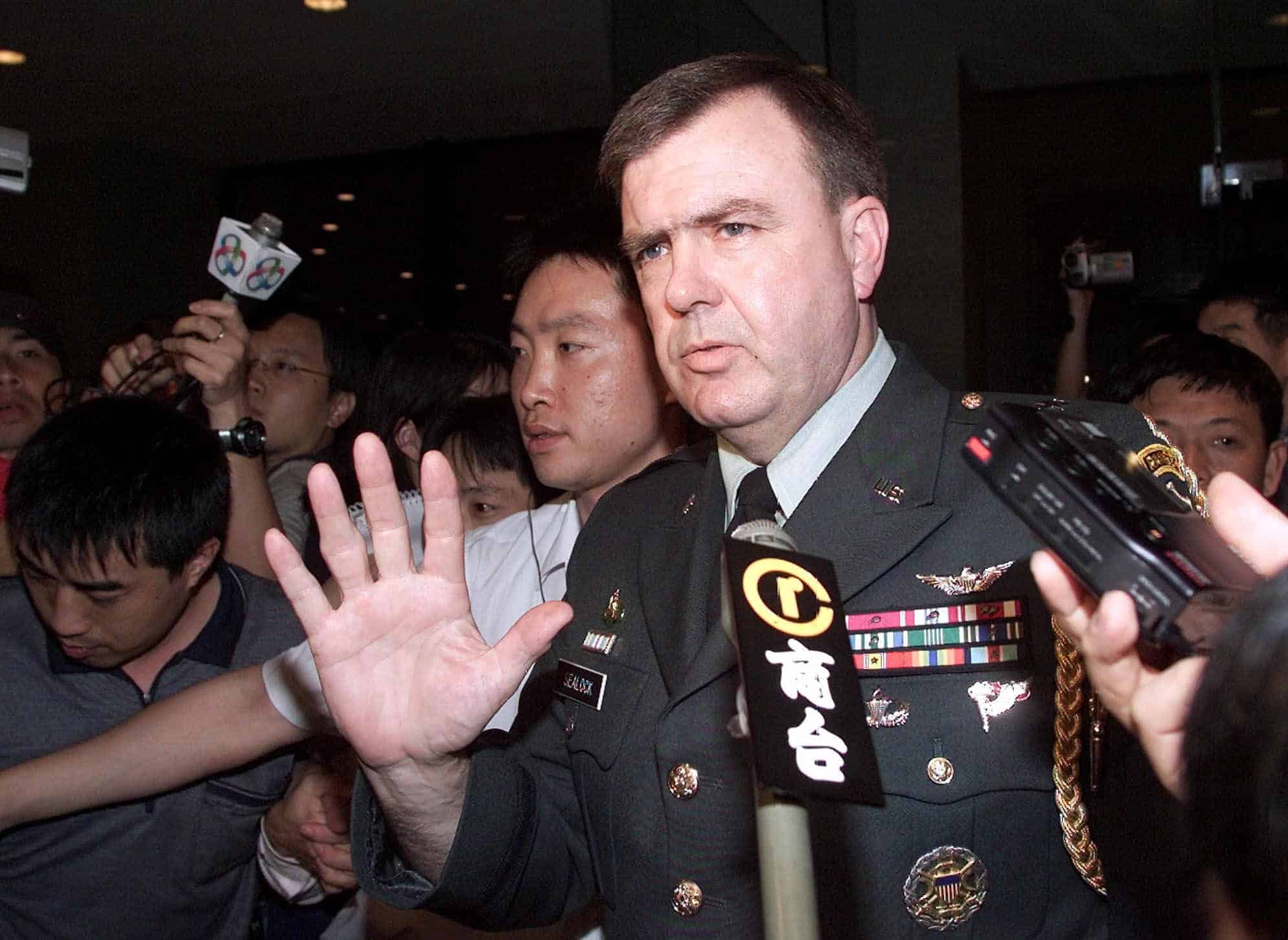
Watching the recent drama around the Chinese surveillance balloon, retired Army Brigadier-General Neal Sealock thought back 22 years. In 2001, he was the defense attaché at the U.S. Embassy in Beijing. When a Chinese fighter jet collided with a U.S. EP-3 reconnaissance plane over the South China Sea on April 1, 2001, killing the Chinese pilot and forcing the EP-3 to make an emergency landing in China — where the 24-person crew was then detained — Sealock handled the negotiations.
Amid a crisis atmosphere, with the story leading the news and rightwing critics in the U.S. baying for tough action, it took almost two weeks of difficult talks with the Chinese authorities to resolve the situation, with Sealock regularly briefing President George W. Bush and others throughout. Eventually, Washington issued a letter expressing “sincere regret” over the Chinese pilot’s death, adding that the U.S. was “very sorry” the plane had entered Chinese airspace and had made an emergency landing “without verbal clearance.”

While Beijing characterized the letter as an apology, Washington insisted that it was simply an expression of regret. In any case, “face” on both sides was maintained, allowing each government to put forward its own spin. The 24 Americans were released. The generally positive trend in Sino-American relations continued, to the point that when the September 11 terror attacks occurred six months later, then-Chinese leader Jiang Zemin was quick to express sympathy for the victims and to support U.S.-backed UN Security Council resolutions condemning terrorism
In Sealock’s view, it was as good an outcome as possible to a diplomatic crisis which, he remains convinced, could have led to a war had the EP-3 crashed and the 24 Americans died. This was in large part because both President Bush and Jiang Zemin were committed to improving Sino-American relations. “Anybody can make a mistake,” he noted. “If they do so, cooler heads have to prevail.”
But today, with U.S.-China relations on a downward spiral, could cooler heads win out in a new crisis? The prospect of another accidental confrontation was underscored in mid-March, when a U.S. Navy destroyer, asserting its right to freedom of navigation, sailed through China-claimed waters in the South China Sea: According to Beijing, China’s navy and air force were mobilized to “warn” the vessel. This followed another near confrontation in late December between a Chinese fighter jet and a U.S. RC-135 reconnaissance plane in the same area.
We don’t have the contacts with the Chinese military. We need to get in place a mechanism by which we can talk to these guys, and not have shots fired.
retired Army Brigadier-General Neal Sealock
In between came the balloon episode, during which China’s defense minister refused to take a call from his U.S. counterpart, Secretary of Defense Lloyd Austin. To Sealock, that was particularly worrying, reviving memories of his initial efforts to resolve the EP-3 plane crisis, when Chinese officials initially refused to pick up the phone. “I tried to call them. Everyone was gone.” It took three days before Sealock was allowed to travel to Hainan and meet the crew, and eight more days of intense negotiations to secure their release.
Today, Sealock believes the situation is much worse. “They won’t talk to you. They won’t answer the phone.”

Part of the problem is that Beijing has long viewed “hot lines” or other channels for urgent communication not as tools to resolve problems, but as a “gift” to be granted for good behavior from Washington — as well as removed as a “punishment” for behavior China dislikes. Making matters worse, there are now very few high-level Chinese officials, especially in the military, who have experience or relationships with their American counterparts. Indeed, within the Chinese system, Sealock believes such a background is now seen as a liability. “If you were a PLA officer selected to study in the U.S. in the past 20 years,” he observes, “you’re done. You’re finished. They’ll let you do a job for a while. But you’re not trusted anymore.”
Meanwhile, on the U.S. side, suspicion of China is almost as intense. The deterioration of ties and the severing of most bilateral exchanges in recent years, coupled with China’s self-imposed isolation during Covid, has reduced the number of China specialists in the U.S. government or military who have had — as Sealock did — extensive experience of living and working in China, or developing relationships with influential Chinese counterparts.
“We don’t have the contacts with the Chinese military,” Sealock says. “We need to get in place a mechanism by which we can talk to these guys, and not have shots fired.”
If the balloon incident is any guide, Beijing’s willingness and ability to respond quickly and deftly to an unfolding crisis is very much in question.
But that is precisely the danger. With China rapidly modernizing its military and expanding activities in the South China Sea and around Taiwan, and the U.S. responding with intensified naval and air patrols, both for reconnaissance and to assert freedom of navigation, the risk of an accidental confrontation is growing.
If the balloon incident is any guide, Beijing’s willingness and ability to respond quickly and deftly to an unfolding crisis is very much in question. Moreover, while President Biden ignored calls from his domestic critics to shoot the balloon down sooner, waiting until it was no longer over land, next time round the toxic politics in Washington may also constrain this and future administrations’ room for maneuver.
“It could be some little minion on the ground, or a bit of bravado like the Chinese pilot in the EP-3 episode,” Sealock notes, “and there you go.”
Click here to read Jordyn Haime’s Q&A with Mike Chinoy on the art of China watching.

Mike Chinoy is a Non-Resident Senior Fellow at the University of Southern California’s U.S.-China Institute and CNN’s former Senior Asia Correspondent. His new book is Assignment China: An Oral History of American Journalists in the People’s Republic



